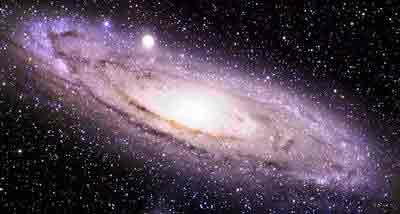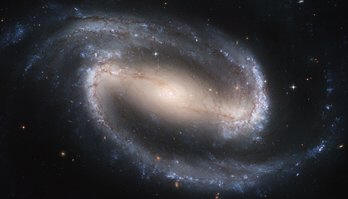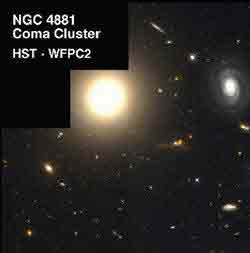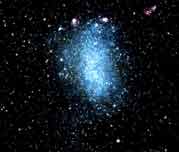|
     
>
History
>
Life Cycle of Galaxy
> Types of Galaxies
> Distribution of
Galaxies
> Milky Way Galaxy
> Andromeda
Galaxy
      
|
Galaxies come in three
main types: elliptical, spirals, and irregulars. A slightly more extensive
description of galaxy types is given by the Hubble sequence which serves
well for many purposes. While the Hubble sequence does encompass all
galaxies, it is entirely based upon visual morphological type. Hence it
may miss the importance of certain characteristics of galaxies such as
star formation rate.
Spiral Galaxy
A spiral galaxy is a type of galaxy in the Hubble sequence which is
characterized by the following physical properties:
- A considerable total angular momentum
- Composed of a central bulge surrounded by a disk
- The bulge resembles an elliptical galaxy, containing many old,
so-called "Population II" stars, and usually a supermassive
black hole
at its center.
- The disk is a flat, rotating assembly consisting of interstellar
matter, young "Population I" stars and open star clusters.
Spiral galaxies are so named due to the bright arms of star formation
within the disk that extend—roughly logarithmically—from the bulge. Though
sometimes difficult to discern, such as in flocculent spirals, these arms
distinguish spiral galaxies from their lenticular counterparts, which
exhibit a disk structure but no evident spiral.
 |
Andromeda Galaxy (Spiral)
The Andromeda Galaxy, a spiral galaxy
similar to our own, though somewhat larger. It is the farthest
object that is visible with the naked eye. It can be seen in the
northern-sky constellation Andromeda. The
Milky Way and
Andromeda
galaxies are the dominant members of the Local Group of galaxies,
which in turn is an outlying part of the Virgo Cluster, which
comprises thousands of galaxies. |
The disks of spiral galaxies tend to be surrounded by large spheroid halos
of Population II stars, many of which are concentrated in globular
clusters that orbit the galactic center.
Our galaxy, the Milky Way, has long been thought to be a spiral, with a
Hubble sequence classification of Sbc (possibly SBb); recent research,
however, suggests that it may in fact be a barred spiral.
The early pioneer of studies on the formation of the spiral arms was
Bertil Lindblad. He realised that the idea of stars arranged permanently
in a spiral shape was untenable due to the "winding dilemma". Since the
speed of rotation of the galactic disk varies with distance from the
centre of the galaxy, a radial arm (like a spoke) would quickly become
curved as the galaxy rotates. The arm would, after a few galactic
rotations, become increasingly curved and wind around the galaxy ever
tighter. This is not what is observed.
The first acceptable theory was devised by C. C. Lin and Frank Shu in
1964. They suggested that the spiral arms were manifestations of spiral
density waves. They assumed that the stars travel in slightly elliptical
orbits and that the orientations of their orbits is correlated i.e. the
ellipses vary in their orientation (one to another) in a smooth way with
increasing distance from the galactic centre. This is illustrated in the
diagram. It is clear that the elliptical orbits come close together in
certain areas to give the effect of arms. Stars therefore do not remain
forever in the position that we now see them in, but pass through the arms
as they travel in their orbits.
Alternative hypotheses that have been proposed involve waves of star
formation moving about the galaxy; the bright stars produced by the star
formation die out quickly, leaving darker regions behind the waves, and
hence making the waves visible.
[Top
Barred Galaxy
A barred spiral galaxy is a spiral galaxy with a band of bright stars
emerging from the center and running across the middle of the galaxy.
Spiral arms appear to emerge from the ends of the "bar" in these galaxies,
whereas they appear to emerge directly from the core in ordinary spiral
galaxies.
Edwin Hubble classified these types of spiral galaxies as "SB" ("Spiral",
"Barred"), and arranged them into three sub-categories based on how open
the arms of the spiral are. SBa types feature tightly bound arms, while
SBc types are at the other extreme and have loosely bound arms. SBb type
galaxies lie in between. A fourth type, SBm, was subsequently created to
describe dwarf barred spirals, such as the Magellanic Cloud galaxies,
which were once classified as irregular galaxies, but have since been
found to contain barred spiral structures.
 |
 |
|
NGC 1300, viewed nearly face-on.
Hubble
Space Telescope image. |
NGC 253, a barred spiral starburst
galaxy, (2MASS). |
Barred spiral galaxies are relatively common, with surveys showing that up
to two-thirds of all spiral galaxies contain a bar. The current hypothesis
is that the bar structure acts as a type of stellar nursery, fueling star
birth at their centers. The bar is thought to act as a mechanism that
channels gas inwards from the spiral arms through orbital resonance, in
effect funneling the flow to create new stars. This process is also
thought to explain why many barred spiral galaxies have active galactic
nuclei, such as that seen in Messier 83.
The creation of the bar is generally thought to be the result of a density
wave radiating from the center of the galaxy whose effects reshape the
orbits of the inner stars. This effect builds over time to stars orbiting
further out, which creates a self-perpetuating bar structure. Another
possible culprit in bar creation are tidal disruptions between galaxies.
Bars are thought to be a temporary phenomenon in the life of spiral
galaxies, the bar structure decaying over time, transforming the galaxy
from a barred spiral to a "regular" spiral pattern. Past a certain size
the accumulated mass of the bar compromises the stability of the overall
bar structure. Barred spiral galaxies with high mass accumulated in their
center tend to have short, stubby bars. Since so many spiral galaxies have
a bar structure, it is likely that it is a reoccurring phenomenon in
spiral galaxy development.
In 2005, observations by the Spitzer Space Telescope backed up previously
collected evidence that suggested the Milky Way is a barred spiral galaxy.
Observations by radio telescopes had for years suggested
our galaxy to be
barred, but Spitzer's vision in the infrared region of the spectrum has
provided a more definite calculation.
[Top]
Elliptical Galaxy
An elliptical galaxy is a type of galaxy in the Hubble sequence
characterized by the following physical properties:
- No or at most an inconsiderable amount
of angular momentum.
- No or at most an inconsiderable amount
of interstellar matter, no young stars, no open star clusters
- Consisted of old, so-called Population
II stars.
- Larger elliptical galaxies typically
have a system of globular clusters, indicating an old population.
 |
NGC 4881 Elliptical Galaxy
The giant elliptical galaxy NGC 4881 (the
spherical glow at upper left) lies at the edge of the Coma Cluster
of Galaxies. |
This traditional portrait of elliptical galaxies paints them as
galaxies where the star formation was over after the initial burst, now
shining only with their aging stars. No significant star formation was
thought to happen. In general they appear yellow-red, which is in contrast
to the distinct blue tinge of a typical spiral galaxy, a colour emanating
largely from the young, hot stars in its spiral arms.
There is a wide range in size and mass for elliptical galaxies: a small as
a tenth of a kiloparsec to over 100 kiloparsecs, and from 107
to 1013 solar masses. The smallest, the Dwarf elliptical
galaxies, may be no larger than a typical globular cluster, but contain a
considerable amount of dark matter not present in clusters. The single
largest known galaxy, M87 (which also goes by the NGC number 4881), is an
elliptical. This range is much broader for this galaxy type than for any
other.
Their shape varies from spherical to highly elongate. The Hubble
classification of elliptical galaxies ranges from E0 for those that are
most spherical, to E7, which are long and thin.
Some recent observations have found young, blue star clusters inside a few
elliptical galaxies, along with other structures that can be explained by
galaxy mergers. Current thinking is that an elliptical galaxy is the
result of a long process where one or more smaller galaxies, of any type,
collide and fuse in a larger one.
This fusion process may at time carry on until recent or contemporary
ages, and is not limited to giant elliptical. For example, our own
Milky
Way is known to be "digesting" a couple of small galaxies right now.
[Top]
Irregular Galaxy
An irregular galaxy is a galaxy that does not fall into the Hubble
classification for galaxies. These are galaxies that feature neither
spiral nor elliptical morphology. They are often chaotic in appearance,
with neither a nuclear bulge or any trace of spiral arm structure.
Collectively they are thought to make up about a quarter of all galaxies.
There are two major Hubble types of irregular galaxies:
- An Irr-I galaxy (Irr I) is an irregular galaxy that features some
structure but not enough to place it cleanly into the Hubble sequence.
de Vaucouleurs subtypes this into galaxies that have some spiral
structure Sm, and those that do not Im.
- An Irr-II galaxy (Irr II) is an irregular galaxy that does not
appear to feature any structure that can place it into the Hubble
sequence.
A  third
classification of irregular galaxies are the dwarf irregulars, labelled as
dI or dIrrs. This type of galaxy is now thought to be important to
understand the overall evolution of galaxies, as they tend to have a low
level of metallicity and relatively high levels of gas, and are thought to
be similar to the earliest galaxies that populated the Universe. They may
represent a local (and therefore more recent) version of the faint blue
galaxies known to exist in deep field galaxy surveys. third
classification of irregular galaxies are the dwarf irregulars, labelled as
dI or dIrrs. This type of galaxy is now thought to be important to
understand the overall evolution of galaxies, as they tend to have a low
level of metallicity and relatively high levels of gas, and are thought to
be similar to the earliest galaxies that populated the Universe. They may
represent a local (and therefore more recent) version of the faint blue
galaxies known to exist in deep field galaxy surveys.
Some irregular galaxy are small spiral galaxies that are being distorted
by the gravity of a larger neighbour.
The Magellanic Cloud galaxies were once classified as irregular galaxies,
but have since been found to contain barred spiral structures, and have
been since re-classified as "SBm", a fourth type of barred spiral galaxy.
[Back] [Top] [Next] |




 third
classification of irregular galaxies are the dwarf irregulars, labelled as
dI or dIrrs. This type of galaxy is now thought to be important to
understand the overall evolution of galaxies, as they tend to have a low
level of metallicity and relatively high levels of gas, and are thought to
be similar to the earliest galaxies that populated the Universe. They may
represent a local (and therefore more recent) version of the faint blue
galaxies known to exist in deep field galaxy surveys.
third
classification of irregular galaxies are the dwarf irregulars, labelled as
dI or dIrrs. This type of galaxy is now thought to be important to
understand the overall evolution of galaxies, as they tend to have a low
level of metallicity and relatively high levels of gas, and are thought to
be similar to the earliest galaxies that populated the Universe. They may
represent a local (and therefore more recent) version of the faint blue
galaxies known to exist in deep field galaxy surveys.